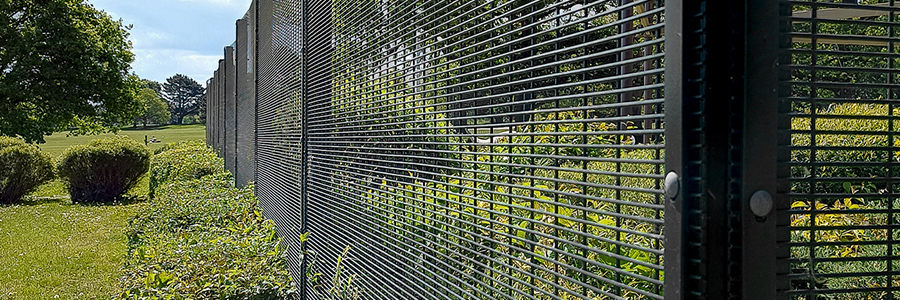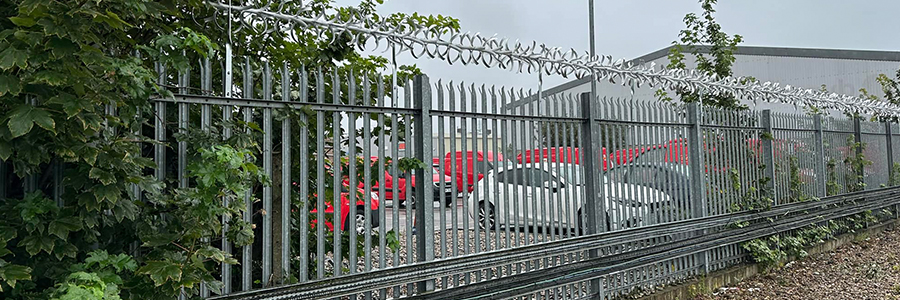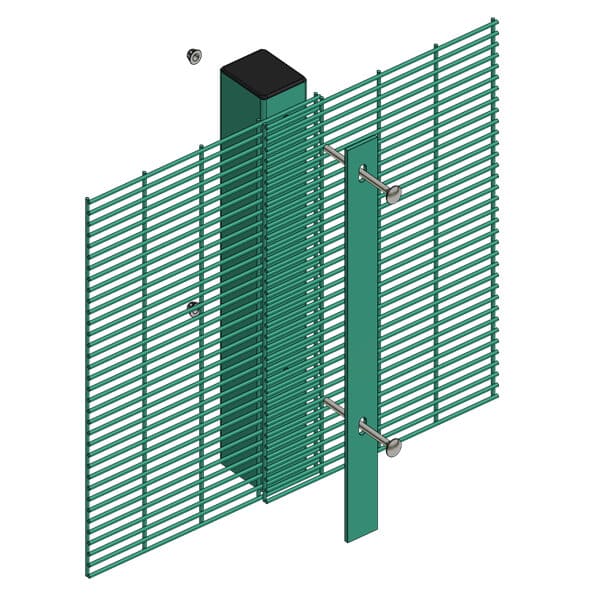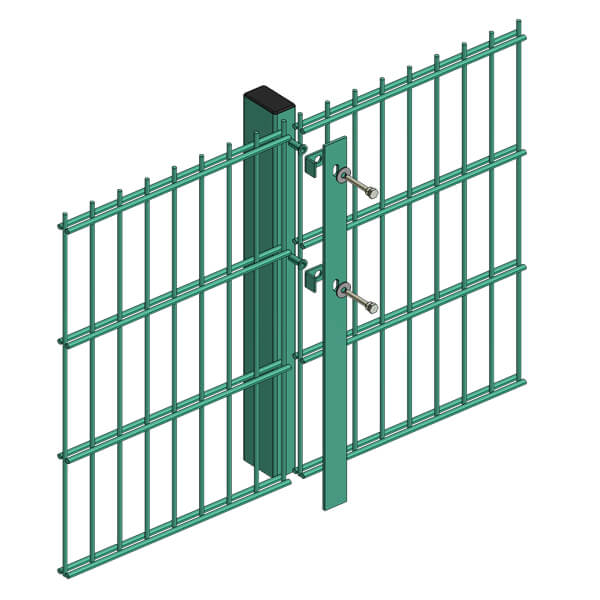Published:
When it comes to perimeter security, not all options are created equal. Some fences are designed simply as boundary markers, while others are designed to resist cutting tools, delay intruders, withstand vehicle attacks and meet strict government security standards (or all of the above). Choosing the right type depends on the risks you’re facing—and that’s where security fencing ratings come in.
Security ratings provide a recognised benchmark, showing how a fence performs under rigorous, independent testing. For specifiers, contractors, and end-users, this certification offers confidence that a system will perform as promised. It also supports proper risk assessment and demonstrates due diligence—often a requirement for insurance and compliance.
In this guide, we’ll break down how fencing security ratings work in the UK, explain what each grade means, and highlight the Alexandra Security products that can help you achieve the right level of protection for your project.
Security Fencing Grades
Security fencing is graded according to how well it withstands different types of attacks, and for how long. These grades aren’t arbitrary; they’re the result of rigorous, independent third-party testing. Fences are subjected to timed assault attempts using specific tool sets, and in some cases, full vehicle impact tests.
The most widely recognised grading systems include:
- LPS 1175 Security Ratings (SR): Measure resistance to forced entry using defined tool kits, with ratings that reflect both the tools used and the time a system can withstand attack.
- ASTM / PAS / K Ratings: Assess a fence’s ability to stop or slow down vehicle impacts, commonly applied to hostile vehicle mitigation (HVM) solutions.
- NPSA Approval: Awarded to fencing systems tested and approved for use in UK government projects and critical national infrastructure.
Each of these systems gives buyers and specifiers confidence that their chosen fence has been independently verified to perform in real-world scenarios—not just in theory.
Who Sets Security Standards for Fencing in The UK?
In the UK, security fencing standards are typically set or overseen by:
- LPCB (Loss Prevention Certification Board): The body that issues the LPS 1175 Security Ratings (SR).
- NPSA (National Protective Security Authority, formerly CPNI): Advises on physical security and approves fencing systems for use in government and critical sites. While NPSA no longer tests fences and gates against the Manual Forced Entry Standard, they still offer guidance.
- British Standards (BS): Provide guidelines for construction and durability.
- International standards bodies: Such as ASTM, for vehicle impact ratings.
Additionally, local police Designing Out Crime Officers (DOCOs) often recommend specific security rating levels for perimeter fencing when reviewing planning applications. Their advice is influenced by factors such as local crime rates, the project’s location, and the expected emergency service response times—all of which help determine the most appropriate level of protection. Engaging with your local Designing Out Crime Officer (DOCO) early in the planning process can be invaluable, helping ensure the security measures specified are both proportionate and effective.
What Do SR Fence Ratings Mean?
The LPS 1175 Security Rating (SR) is the most widely used rating system in the UK for physical security products like security fences and doors. The ratings are awarded by the Loss Prevention Certification Board (LPCB), part of the BRE Group, which has been independently testing and certifying products since 1868.
Each SR level defines how long a fence can withstand a sustained attack, and the type of tools used. The higher the rating, the more capable the fence is against determined intruders with advanced equipment.
Here’s what each level means:
- SR1 (A1): Resists opportunistic attempts with basic tools (e.g. screwdrivers, knives, pliers) for at least 1 minute.
- SR2 (B3): Withstands more determined attacks using a wider toolset, including crowbars and drills, for at least 3 minutes.
- SR3 (C5): Defends against experienced intruders with heavy-duty tools such as axes, bolt cutters, and larger crowbars, for at least 5 minutes.
- SR4 (D10): Designed to resist professional-grade tools, including grinders, drills, and sledgehammers, for at least 10 minutes.
- SR5 and above: Tested to withstand advanced, prolonged attacks lasting 10–30 minutes, often using specialist power tools. These ratings are typically required for critical national infrastructure and high-value, high-risk sites.
In short, the higher the SR rating, the longer the fence can resist attack and the more sophisticated the tools it has been proven to withstand—giving specifiers a clear benchmark when matching perimeter protection to site-specific risks.
What is a K4-rated Fence?
While SR ratings deal with bodily physical force and tools, K-ratings relate to vehicle impact. They’re based on the US Department of State (DoS) standards but are often referenced globally.
- K4: Stops a 6.8-tonne vehicle travelling at 48km/h (30 mph)
- K8: Stops the same vehicle at 64km/h (40 mph)
- K12: Stops it at 80km/h (50 mph)
Fences with these ratings are commonly used around embassies, military sites, airports, and high-value commercial sites.
What’s an NPSA-Approved Fence?
An NPSA-approved fence isn’t just any product with a lofty name—it’s one that meets stringent government-endorsed criteria tailored for high-risk and highly sensitive environments. The NPSA focuses on providing expert guidance that ensures that the selected perimeter solutions align with identified threats, such as forced entry, terrorist attacks, or vehicle-borne threats. The key expectations are:
- The fence system must comply with recognised testing standards and be verified by an independent test house.
- The selection of a standard should stem from a site-specific Operational Requirements (OR) process, which assesses threats like criminality, terrorism, or hostile state actors.
- Approved systems are listed in the NPSA’s Catalogue of Security Equipment (CSE)—a controlled resource specifying products deemed appropriate for government and critical national infrastructure use.
Do Higher Security Ratings Mean a Fence is Taller or Thicker?
Not always, no. While it’s true that high-security fences often use heavier-duty mesh and posts, ratings are based on performance, not simply size. For example, a fence might not look particularly imposing, but the specifics of its design and fixings may make it extremely difficult to cut through or climb.
So, the effectiveness of a fence depends as much on its construction and quality of materials as it does on its overall height.
Can a Fence Lose Its Security Rating Over Time?
Yes, if it isn’t maintained properly. Rust, damaged fixings, or unauthorised modifications can compromise performance in even the best security enclosures. To maintain a security rating, fencing should be regularly inspected and repaired, and coatings should be maintained to prevent corrosion. Every fencing system should come with an operations and maintenance manual which will explain the required maintenance steps needed. Regular maintenance is often a requirement in any warranty or guarantee provided by the manufacturer.
That’s why it’s important to invest in high-quality systems with galvanised or powder-coated finishes, like our Protek Mesh Range, which are designed for long-lasting protection.
What Type of Security Fence Do I Need?
The right fence depends on your site’s risk level:
- Low to medium risk: For schools, business parks, or public spaces, V-mesh systems like Protek 1000 or twin-wire systems such as Protek 656 provide reliable boundary protection.
- Medium to high risk: Industrial estates, retail parks, and sports enclosures often use the Protek 868 Elite SR1-rated fence or the Protek 358 Elite for greater strength and resilience. For higher risk sites such as Data Centres, Logistics Depots and National Infrastructure, an SR2 rated system such as Protek Elite Defender provides a much higher level of protection.
- Privacy and discretion: The Protek Privacy system combines robust mesh with timber infills for both security and concealment.
- High-risk or critical infrastructure: For sites that require SR or NPSA-approved systems, speak to Alexandra Security about specialist fencing solutions designed to meet these stringent standards.
Want To Invest in a Secure Fence?
Security ratings take the guesswork out of choosing fencing. Whether you need to deter opportunists, stop vehicles, or meet the highest government standards, the right product is out there – and Alexandra Security can help you find it.
Explore our full range of mesh security fencing to discover systems that combine proven performance with long-lasting protection.










